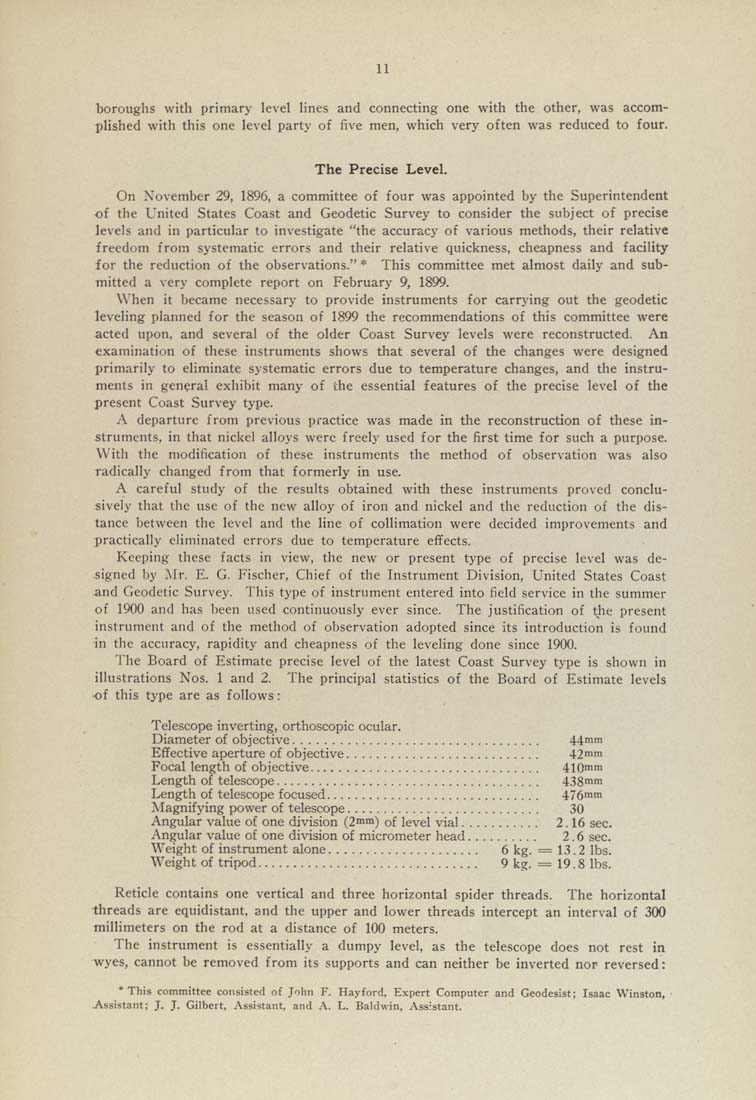boroughs with primary level lines and connecting one with the other, was accom¬
plished with this one level party of five men, which very often was reduced to four.
The Precise Level.
On November 29, 1896, a committee of four was appointed by the Superintendent
of the United States Coast and Geodetic Survey to consider the subject of precise
levels and in particular to investigate "the accuracy of various methods, their relative
freedom from systematic errors and their relative quickness, cheapness and facility
for the reduction of the observations." * This committee met almost daily and sub¬
mitted a very complete report on February 9, 1899.
When it became necessary to provide instruments for carrying out the geodetic
leveling planned for the season of 1899 the recommendations of this committee were
acted upon, and several of the older Coast Survey levels were reconstructed. An
examination of these instruments shows that several of the changes were designed
primarily to eliminate systematic errors due to temperature changes, and the instru¬
ments in general exhibit many of the essential features of the precise level of the
present Coast Survey type.
A departure from previous practice was made in the reconstruction of these in¬
struments, in that nickel alloys were freely used for the first time for such a purpose.
With the modification of these instruments the method of observation was also
radically changed from that formerly in use.
A careful study of the results obtained with these instruments proved conclu¬
sively that the use of the new alloy of iron and nickel and the reduction of the dis¬
tance between the level and the line of collimation were decided improvements and
practically eliminated errors due to temperature effects.
Keeping these facts in view, the new or present type of precise level was de¬
signed by Mr. E. G. Fischer, Chief of the Instrument Division, United States Coast
and Geodetic Survey. This type of instrument entered into field service in the summer
of 1900 and has been used continuously ever since. The justification of the present
instrument and of the method of observation adopted since its introduction is found
in the accuracy, rapidity and cheapness of the leveling done since 1900.
The Board of Estimate precise level of the latest Coast Survey type is shown in
illustrations Nos. 1 and 2. The principal statistics of the Board of Estimate levels
•of this type are as follows:
Telescope inverting, orthoscopic ocular.
Diameter of objective.................................. 44mm
Effective aperture of objective........................... 42"""
Focal length of objective................................ 410nim
Length of telescope..................................... 438"""
Length of telescope focused.............................. 476'nm
Magnifying power of telescope........................... 30
Angular value of one division (2«<«n) of level vial........... 2.16 sec.
Angular value of one division of micrometer head.......... 2.6 sec.
Weight of instrument alone..................... 6 kg. ^ 13.2 lbs.
Weight of tripod............................... 9 kg. = 19.8 lbs.
Reticle contains one vertical and three horizontal spider threads. The horizontal
threads are equidistant, and the upper and lower threads intercept an interval of 300
millimeters on the rod at a distance of 100 meters.
The instrument is essentially a dumpy level, as the telescope does not rest in
wyes, cannot be removed from its supports and can neither be inverted nor reversed:
"This committee consisted of John F. Hayford, Expert Computer and Geodesist; Isaac Winston,
Assistant; J. J. Gilbert. Assistant, and A. L. Baldwin, Assistant.
|








